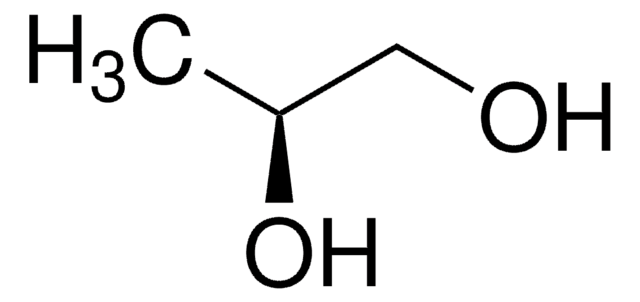Wichtige Dokumente
82280
1,2-Propandiol
puriss. p.a., ACS reagent, ≥99.5% (GC)
Synonym(e):
Propylenglykol
About This Item
Empfohlene Produkte
Qualität
ACS reagent
puriss. p.a.
Qualitätsniveau
Dampfdichte
2.62 (vs air)
Dampfdruck
0.08 mmHg ( 20 °C)
Assay
≥99.5% (GC)
Form
viscous liquid
Selbstzündungstemp.
779 °F
Haltbarkeit
3 yr
Expl.-Gr.
12.5 %
Verunreinigungen
≤0.003% free acid (as CH3COOH)
≤0.1% water
Abdampfrückstand
≤0.005%
Glührückstand
<0.005% (as SO4)
Brechungsindex
n20/D 1.432 (lit.)
n20/D 1.433
bp
187 °C (lit.)
mp (Schmelzpunkt)
−60 °C (lit.)
Dichte
1.036 g/mL at 25 °C (lit.)
Anionenspuren
chloride (Cl-): ≤1 mg/kg
sulfate (SO42-): ≤20 mg/kg
Kationenspuren
Ca: ≤5 mg/kg
Cd: ≤1 mg/kg
Co: ≤1 mg/kg
Cr: ≤1 mg/kg
Cu: ≤1 mg/kg
Fe: ≤1 mg/kg
K: ≤20 mg/kg
Mg: ≤1 mg/kg
Mn: ≤1 mg/kg
Na: ≤20 mg/kg
Ni: ≤1 mg/kg
Pb: ≤1 mg/kg
Zn: ≤5 mg/kg
SMILES String
CC(O)CO
InChI
1S/C3H8O2/c1-3(5)2-4/h3-5H,2H2,1H3
InChIKey
DNIAPMSPPWPWGF-UHFFFAOYSA-N
Suchen Sie nach ähnlichen Produkten? Aufrufen Leitfaden zum Produktvergleich
Allgemeine Beschreibung
Anwendung
Lagerklassenschlüssel
10 - Combustible liquids
WGK
WGK 1
Flammpunkt (°F)
219.2 °F - closed cup
Flammpunkt (°C)
104 °C - closed cup
Persönliche Schutzausrüstung
Eyeshields, Gloves
Hier finden Sie alle aktuellen Versionen:
Besitzen Sie dieses Produkt bereits?
In der Dokumentenbibliothek finden Sie die Dokumentation zu den Produkten, die Sie kürzlich erworben haben.
Kunden haben sich ebenfalls angesehen
Chromatograms
suitable for GCsuitable for GCUnser Team von Wissenschaftlern verfügt über Erfahrung in allen Forschungsbereichen einschließlich Life Science, Materialwissenschaften, chemischer Synthese, Chromatographie, Analytik und vielen mehr..
Setzen Sie sich mit dem technischen Dienst in Verbindung.



